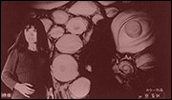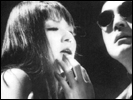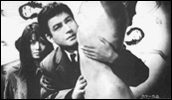The Blind Beast
- Year
- 1969
- Original title
- Moju
- Japanese title
- 盲獣
- Director
- Cast
- Running time
- 84 minutes
- Published
- 20 March 2001



by Jasper Sharp
One of the most fascinatingly freakish of all the big screen adaptations of the works of Japanese mystery writer Edogawa Rampo is The Blind Beast. This outrageous film from 1969 was directed by the criminally underrated Yasuzo Masumura, director of such powerful melodramas as Kisses (Kuchizuke, 1957), Giants and Toys (Kyojin to Gangu, 1958), the lesbian love-triangle Manji (1964), and Red Angel (Akai Tenshi, 1966). Masumura's early work and essays on film in the late 1950s spurred a young Nagisa Oshima and his peers at Shochiku studios to radically reconfigure the nation's traditional cinema, giving birth to the Japanese New Wave of the 60s in the process.
Though the plot bears some similarity to John Fowles' powerful novel The Collector, published in 1963 and rather listlessly adapted for the big screen by William Wyler in 1965 with Terence Stamp and Samantha Eggar as captor and captured, Moju is based on a rather grotesque tale by Rampo first serialised in the Asahi national newspaper between 1931 and 1932.
The original story featured Michio, a psychopathic blind sculptor who under the guise of an itinerant masseur roams the land in search of suitable female body parts to construct into the perfect sensual sculpture. In Masumura's hands the plot is stripped down to its basic atoms. There is only one victim here to form the basis of the sculptor's latest work, a shapely young model called Aki, abducted in the initial scenes. The rest of the action takes place in one location, the artist's cavernous studio in the basement of a secluded house, each wall covered in biomorphic swells representing parts of the female anatomy: breasts, eyes, lips. The studio is dominated by two recumbent sculptures of male and female nudes.
Masumura depicts this claustrophobic milieu with an edgy, hallucinogenic intensity that borders on hyper-realism to explore the cloying, all-encompassing relationship between the artist and his art and the obsessive closed world that the artist inhabits. As Michio maps out the curves of his subject in his attempt to reproduce her in clay, the two engage in a continuous stream of dialogue, and as Aki's fear for her capture turns to respect, she eventually reciprocates to his intense tactile fixation on her body. The two enter into a strange sado-masochistic relationship that, in a squirm-inducing finale reminiscent of Nagisa Oshima's In the Realm of the Senses (Ai No Koriida, 1976) and Jennifer Lynch's Boxing Helena (1993), culminates in each of the model's limbs being severed from her torso.
Given the rather static nature of the mise-en-scène, Masumura must be admired for stretching out such an elementary idea to feature length, yet the most overwhelming impression of this film is its deliciously overwrought visual style, conjuring up such a vivid and endlessly interesting, self-contained cinematic world inside the claustrophobic confines of Michio's studio. Yes, The Blind Beast really is as outlandish as it sounds, and must rank as one of the most powerful and potently disturbing horror films ever conceived. For anyone with any interest in the horror/fantasy genre, this is quite simply mandatory viewing. A classic.